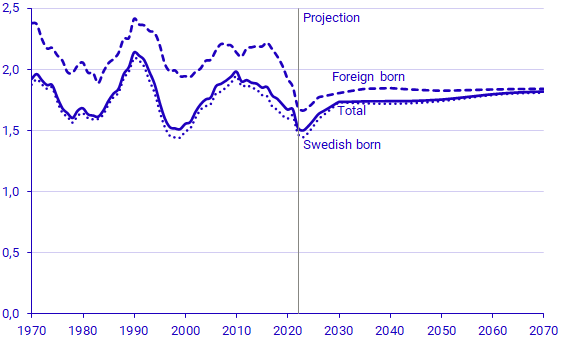Children per woman by country of birth 1970–2022 and projection 2023–2070

Comments
Period fertility is measured with the total fertility rate. The total fertility rate is a measure of the total number of children a woman would give birth to if birth rates (i.e., the average number of births per women at different ages) were the same during her lifetime as during the year for which the calculation was made.
The total fertility rate has varied over the years in Sweden due to several reasons. The downturn in childbearing observed from the end of the 1960s until the middle of the 1980s was due, in large part, to an increasing share of women joining the workforce. Even the access to better and safer birth control methods contributed to that decrease.
The decrease was replaced by an upswing in the years around 1990, a period when the economy was strong and changes in family policy occurred. A downturn in childbearing occurred again during the late 1990s. The downturn of the 1990s is typically explained by the downturn in the economy. Younger women and men, in particular, faced greater obstacles to establish themselves in the labour market. An increasing number went on to higher education and postponed having children. In 1999, Sweden had the lowest total fertility rate since the 1970s, at 1.5 children per woman. Childbearing increased during the 2000s up to 2010 but declined thereafter. In 2022, the total fertility rate was close to the lowest observed, 1.52 children per woman.
It is likely that the total fertility rate will oscillate more from year-to-year in the future than is assumed in the forecast. The assumption is more a representation of the long-term trend in childbearing than an assumption about the most probable level in a given year. Attempts to estimate the effect of short-term factors in relation to childbearing, such as economic fluctuations, were only done for the first few years of the forecast.
The fertility rate among women born in Sweden and foreign born women have largely followed the same variations over time, albeit higher fertility levels among foreign born women. Foreign born women often have an elevated fertility in the years shortly after immigration. Furthermore, some foreign born women emigrate after a few years in Sweden. Together, those two factors imply that some foreign born women are not in Sweden during their complete fertility period, but only during a period when they are more likely to give birth. A consequence of this pattern is that birth rates for foreign born based on a single calendar years are often high. During the projection period, the total fertility rate for foreign born women is expected to continue to be at a higher level than the fertility rate for Swedish-born women but, in the long term, the differences are expected to decrease.
In the short term, this projection can be regarded as a population forecast. In the long term, the projection should be regarded as precisely a projection of the population in the case that current behaviour and trends continue in the future. Furthermore, an assumption is made that regulations that apply today will continue to apply throughout the projection period. Already in the short term, changes in society or in the world around us may mean that projection conditions will change.